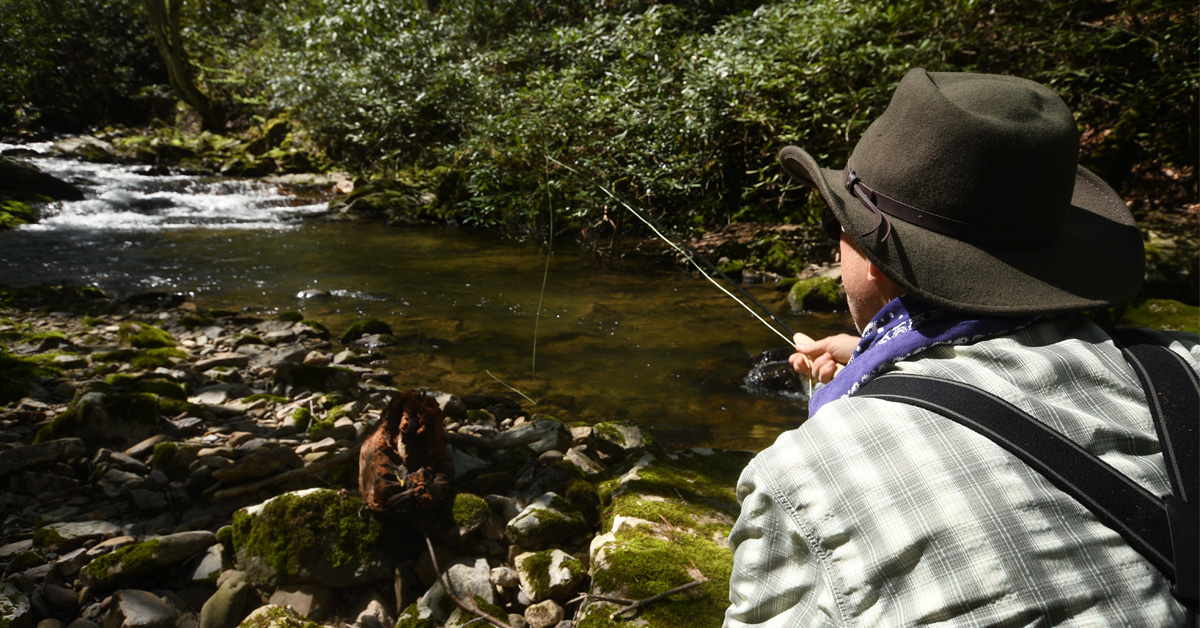
Most of the streams in the Mount Rogers region begin at or above 4,500 feet above sea level, and remain above 2,500 feet for the majority of their route, keeping them relatively cool, even throughout most of the summer.
By Matt Reilly
Photos by Matt Reilly
It’s June, which means summer is on its way and trout stocking is ceasing across the state. The delay on delayed harvest fisheries is over. Water temperatures are rising, and on hatchery-supported trout waters, they are rapidly reaching the upper temperature threshold for trout survival. In another month, only the high-elevation streams—and those with plenty of groundwater influence—will remain cold enough to hold happy, thriving populations of trout that can be responsibly angled to. Thankfully, in the highlands of southwest Virginia, such streams abound.
About 760 million years ago, when the ancient supercontinent, Rodinia, was still intact, stretching and heating of the Earth’s crust along divergent plate boundaries inspired active volcanoes along the rift that would one day become the Appalachian Mountains. Geological record suggests that one such volcano at the site of what is today Mount Rogers—Virginia’s highest point—erupted several times, spewing a hot, dense flood of volcanic ash over the surrounding landscape that settled and cooled to become a layer of volcanic rock more than a third of a mile thick, raising the region into the sky.
Another million or so years later, ancient glaciers dominated the landscape, smoothing and carving their own impressions into the rugged terrain.
The (currently) 5,729-foot Mount Rogers and the surrounding high country is the impressive final product of the two combined forces.
More than 200,000 acres of this high elevation land is protected by the Mount Rogers National Recreation Area (MRNRA), an inset of the massive Jefferson National Forest, which serves as a buffer, keeping the well over 100 miles of trout water clean. Moreover, the highland climate present in the MRNRA keeps the streams cooler and fuller than those in the majority of the rest of the state, creating ample opportunities for the trout angler year-round.
Streams like Whitetop Laurel Creek, Fox Creek, and Big Wilson Creek in Grayson Highlands State Park begin their freestone journey around or above 4,500 feet above sea level, and remain above 2,500 feet above sea level for the majority of their downhill routes. Not only are these streams fishable throughout most of the summer, but they can offer some of the best dry fly fishing of the year.
For the most part, aquatic macroinvertebrates progress from their larval to their adult life stages during the spring months. Though there are some exceptions, the months of March, April, and May are, for this reason, well known for their hatches and the accompanying dry fly fishing that trout anglers are so fond of. But during the warmest months of the year, terrestrial insects become more active and abundant. From June until October, trout anglers will do well to carry an assortment of flies imitating ants, beetles, grasshoppers, and inchworms. When splatted on the surface near overhanging cover, opportunistic trout will take such food sources recklessly, at times. Or, they may rise slowly and deliberately to take an easy meal floating downstream, trapped in the surface film.

Dry fly fishing can be excellent provided you can find cold water in the summertime. Terrestrial insects like grasshoppers, beetles, ants, and inchworms reach peak activity, and trout feed on them heavily when they end up in the stream.
Also of note is the presence of giant black stoneflies in most all of the streams in the region. These aquatic insects emerge into adulthood in the late-spring to early-summer timeframe and are eaten readily by surface feeding trout when they return to the stream to lay eggs. The classic Stimulator fly is a fantastic imitation of this specific insect, but can also be fished with success as a general attractor or terrestrial imitation throughout the summer.
When trout fishing during the warmer summer months, be aware that it’s wise to understand the relationship between trout health and water temperature, and plan your fishing strategically with Safe Practices for Summer Trout Fishing.
Matt Reilly is a full-time freelance writer, outdoor columnist, and fly fishing guide based in southwest Virginia.


